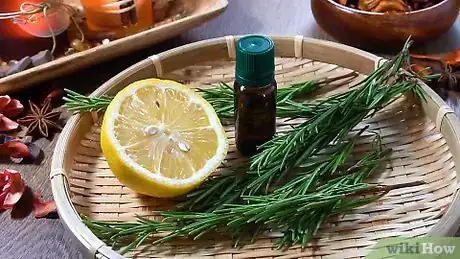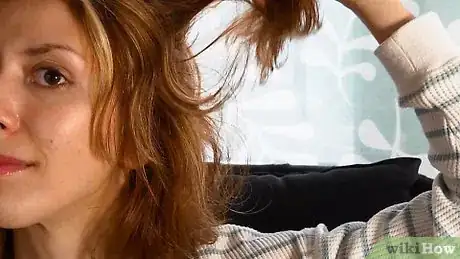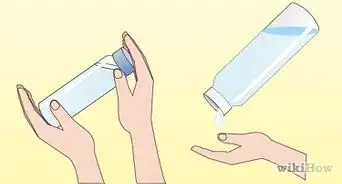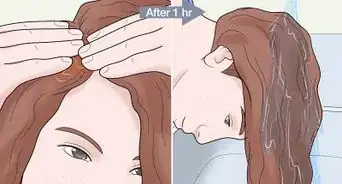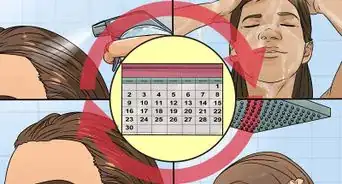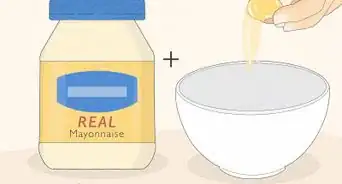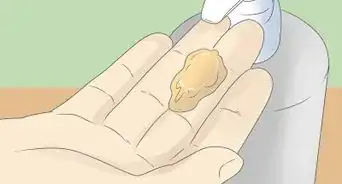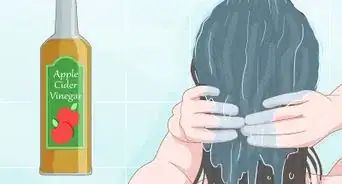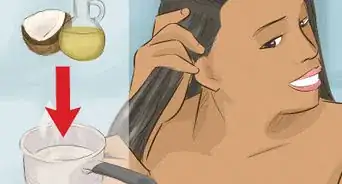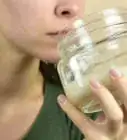This article was co-authored by wikiHow Staff. Our trained team of editors and researchers validate articles for accuracy and comprehensiveness. wikiHow's Content Management Team carefully monitors the work from our editorial staff to ensure that each article is backed by trusted research and meets our high quality standards.
There are 7 references cited in this article, which can be found at the bottom of the page.
The wikiHow Video Team also followed the article's instructions and verified that they work.
This article has been viewed 47,963 times.
Learn more...
Shampoo can be a fun, cheap do-it-yourself experiment for you, or it might already be a way of life. Making your own shampoo gives you control over what goes on your body and down your drain, meaning homemade shampoo can be a healthy and more environmentally friendly alternative to some store-bought products. There are also endless possibilities in terms of shampoo recipes and substitute ingredients, so you can customize your suds for dry or oily hair, sensitive skin, for health and skin related ailments, or even just depending on the mood you’re in! There are many ingredients you can use to moisturize and take care of your hair and scalp, and lots of essential oils to choose from if you’re suffering from any conditions, or have hair problems you want to address.
Ingredients
- ½ cup (118 ml) distilled water
- ¼ cup (59 ml) liquid castile soap
- 2 teaspoons (10 ml) avocado oil
- 5-10 drops peppermint essential oil
- 5-10 drops tea tree essential oil
- 1 teaspoon (10 ml) vegetable glycerin
- 10-15 drops essential oils (optional)
- 6 ounces (177 ml) aloe vera gel
- 3 tablespoons (44 ml) olive oil
- 10 teaspoons (50 grams) baking soda
- 20 drops rosemary oil
- 10 drops peppermint oil
- 1 14-ounce (414 ml) can full fat coconut milk
- 2 teaspoons (10 ml) liquid raw honey
- 1 teaspoon (5 ml) jojoba oil
- 1 teaspoon (5 ml) castor oil
- 2 teaspoons (10 ml) apple cider vinegar
- 20-25 drops essential oils (optional)
Steps
Selecting Shampoo Ingredients
-
1Understand your scalp’s pH balance. Your skin and scalp have a natural pH level between 4.5 and 5.5, and your shampoo and conditioner should have a pH level that matches your body. Many homemade shampoo recipes call for products that are too alkaline (like baking soda) or too acidic (like vinegar) without balancing them out, meaning they won’t have the right pH level for your scalp. Signs that your hair care products don’t have the right pH level include:[1]
- Eczema and psoriasis on the scalp
- Mold or fungal infections
- Dry or itchy scalp
- Dandruff or flaking
- Hair loss or breakage
-
2Use moisturizing oils and ingredients. Along with traditional moisturizers like aloe, coconut oil, and olive oil, there are also many essential oils you can add to your shampoo to make it more moisturizing and nourishing. Especially if you have dry hair, try oils such as:[2]
- Cedar wood and clary sage, which are also good for thin hair
- Chamomile
- Lavender and ylang-ylang
- Rosemary and thyme
Advertisement -
3Find ingredients to treat other scalp issues. There are many hair-related problems that people suffer from, including brittle or dull hair, oily hair, hair loss, dry scalp, and dandruff. Luckily, there are also many essential oils available that are great for healthy hair, treating problems, and improving the look and feel of your hair.
- To treat a dry scalp or dandruff, use lemon, lavender, tea tree, and rosemary in your shampoo.
- To strengthen your hair or help reduce hair loss, try clary sage, lavender, wild orange, rosemary, and peppermint.
- For added luster and shine, try sweet basil, chamomile, and lavender.[3]
- To treat oily hair, add some bergamot, cedar wood, lemon, pine, or ylang-ylang to your shampoo.[4]
-
4Learn proper hair care techniques. While personal hygiene routines are quite personal, there are definitely some right and wrong ways of washing, drying, combing, and styling your hair that can lead to damaged and unhealthy hair.
- Always work shampoo into a lather in your hands before applying it to your scalp. Massage your scalp with the shampoo to ensure you clean it properly and remove dirt and debris.[5]
- Always use a wide-toothed comb to brush your hair, or if you want to use a brush, make sure it has plastic bristles that are tipped with protective balls.[6]
Making Basic Shampoo
-
1Gather your ingredients and container. Old shampoo bottles or mason jars are great for homemade soaps, but be sure to rinse them out first. Grab your castile soap, oil, glycerine, and essential oils.[7]
- The glycerine will help give the shampoo a little more body and make it less runny.
-
2Add beer for more body and shine. Beer can actually help give your hair more bounce and luster, and you can still find this as an ingredient in many artisan shampoos today.
- Take one cup (237 ml) of beer and heat it in a pot on the stove. Reduce it to one-quarter cup (59 ml) and allow to cool.[8]
-
3Mix your ingredients. Pour all the ingredients into your bottle. Shake well and it’s ready to use! Always shake your shampoo before use.
Making Soap-Free Shampoo
-
1Determine if you need soap-free shampoo. Some medical conditions, such as eczema and psoriasis, are exacerbated by soaps and shampoos. In such cases, soap-free shampoo, which is also called no-poo, can act as a suitable alternative for washing hair.
- Many people believe that shampoo causes our scalps to produce more oil, and that no-poo will reverse this process. However, the amount of oil your scalp produces is genetic, and has nothing to do with your shampoo.[9]
-
2Gather your ingredients and bottle. Aloe is important in this recipe as a moisturizer, but it also has a pH between 4.5 and 5.5, making it perfectly matched to your skin and scalp.
- The essential oils in this recipe can be substituted for others, depending on your needs or personal preferences.
-
3Mix the ingredients. Pour all the ingredients into an old shampoo bottle or mason jar and mix well. Always shake before using.
Making pH Balanced Shampoo
-
1Grab your tools. Along with your shampoo ingredients and bottle, you will also need a medium bowl and a whisk.
-
2Mix your ingredients. Pour all the ingredients, including any essential oils you’re using, into your bowl. Whisk them together until the mixture is smooth. Transfer to your bottle or mason jar.
-
3Massage into hair. Shake your shampoo before each use. Massage a small amount into your scalp and let rest for two to three minutes. Rinse with clean water.
Community Q&A
-
QuestionFor how long can I keep and use homemade shampoos after they're made?
 Community AnswerAny homemade shampoo that doesn't have an added preservative should be refrigerated between uses and you can probably expect a shelf life of 4-6 weeks with proper care. But, you should carefully monitor it for any changes (like color or odor) that may indicate a bacterial or mold growth.
Community AnswerAny homemade shampoo that doesn't have an added preservative should be refrigerated between uses and you can probably expect a shelf life of 4-6 weeks with proper care. But, you should carefully monitor it for any changes (like color or odor) that may indicate a bacterial or mold growth. -
QuestionRegarding the soap-free shampoo, what is the use of baking soda?
 TamaraTop AnswererBaking soda will clean your hair and scalp (removes oil) and because it is a bit gritty, it helps loosen any build up of hair products.
TamaraTop AnswererBaking soda will clean your hair and scalp (removes oil) and because it is a bit gritty, it helps loosen any build up of hair products. -
QuestionCan adding essential oils and vitamin E help preserve the shampoo? Or are there any other natural alternatives for preserving a no-poo?
 Community AnswerWhen you apply vitamin E to your scalp, it helps reduce inflammation and repair damage to the follicles, and healthy follicles encourage hair growth. If you do want to apply essential oils for some scalp benefits, hair growth, fragrance, and calming effects, add oil to hair products.
Community AnswerWhen you apply vitamin E to your scalp, it helps reduce inflammation and repair damage to the follicles, and healthy follicles encourage hair growth. If you do want to apply essential oils for some scalp benefits, hair growth, fragrance, and calming effects, add oil to hair products.
References
- ↑ http://www.aloeplant.info/aloe-for-hair-loss-ph-balancer/
- ↑ http://www.almanac.com/content/recipes-homemade-toiletries-soaps-shampoos-and-more
- ↑ http://www.almanac.com/content/recipes-homemade-toiletries-soaps-shampoos-and-more
- ↑ http://www.almanac.com/content/recipes-homemade-toiletries-soaps-shampoos-and-more
- ↑ http://www.motherearthliving.com/natural-beauty/shimmer-and-shine-with-homemade-herbal-shampoos.aspx
- ↑ http://www.cnn.com/2012/01/13/living/hair-myths-o/index.html
- ↑ http://www.thankyourbody.com/all-natural-shampoo/
- ↑ http://www.motherearthliving.com/natural-beauty/shimmer-and-shine-shampoos-beer.aspx
- ↑ http://www.cnn.com/2012/01/13/living/hair-myths-o/index.html
About This Article
If you want to make homemade shampoo, mix castile soap, oil, glycerine, and essential oils like cedarwood oil, lavender, or rosemary. If you want your hair to have more body and shine, reduce 1 cup of beer down to 1/4 cup on the stove and add it to your shampoo as well. Pour all of the ingredients into a bottle and shake it well before each use. If you’d like to learn how to make soap-free shampoo, read on!

